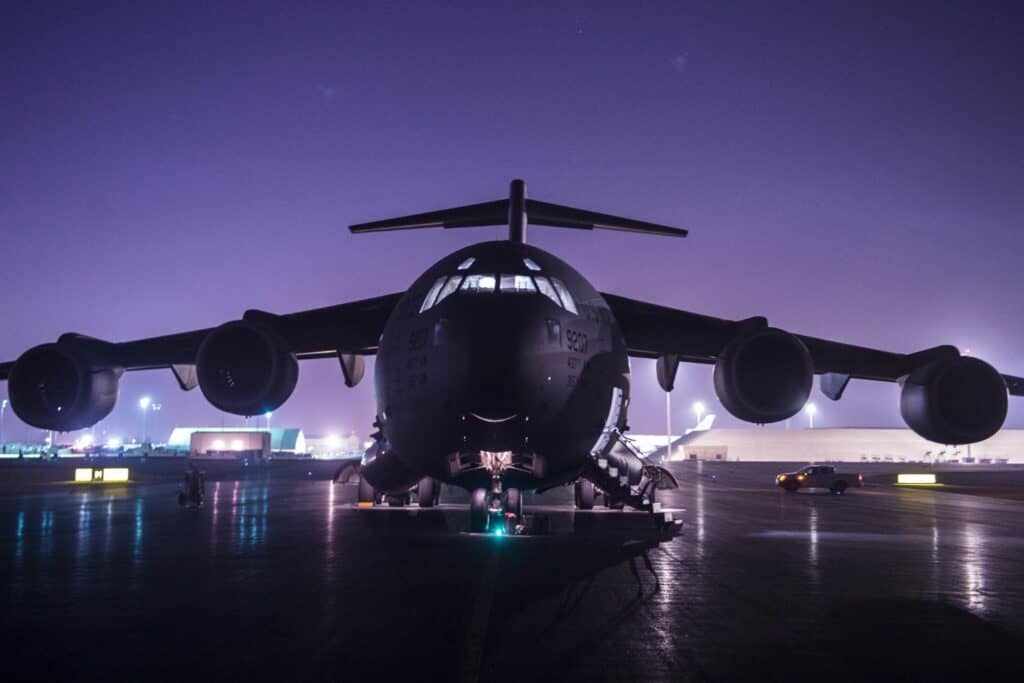
One of the most frequently asked questions from new Space-A travelers is: how do I know which bases have flights to the places I want to go?
Due to the nature of Space-A travel, there is no single source that lists all military passenger terminals and where they have flights. “Space-A flights” are simply military missions that have extra seats.
Most missions are between U.S. military bases or to/from one of the Air Mobility Command (AMC) terminals at civilian airports (Seattle Tacoma International and Baltimore Washington International). You could see a flight to just about anywhere, if mission dictates, but those opportunities, such as missions to other civilian airports or foreign military bases, are sporadic.
With that in mind, it is possible to learn where you have the best chances of getting from point A to point B. Here’s how to figure it out.
Note: To learn the entire process for flying Space-A or “taking a hop,” read our Quickstart Guide to Military Space-A Flights.
Contents (click to expand)
Where are the Military Passenger Terminals?
If you want to know what military passenger terminals are closest to you, the best place to start is the AMC Travel Site.
Scroll down to the passenger terminal directory, which lists U.S. military passenger terminals around the world. It’s organized into seven sections:
- AMC CONUS Terminals (AMC terminals in the contiguous U.S.)
- EUCOM Terminals (AMC terminals within European Command)
- INDOPACOM Terminals (AMC terminals within Indo-Pacific Command)
- CENTCOM Terminals (AMC terminals within Central Command)
- SOUTHCOM Terminals (AMC terminals within Southern Command)
- Non-AMC CONUS Terminals (Terminals in CONUS that do not fall under Air Mobility Command)
- ANG & Reserve Terminals (Air National Guard and Reserve terminals. All are in CONUS.)
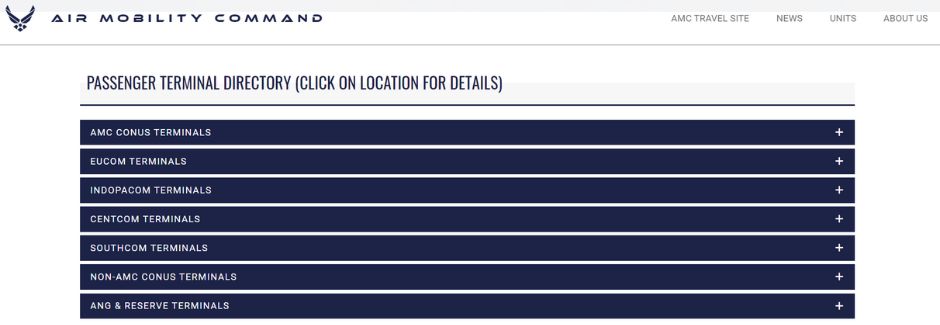
On the AMC Travel Site, If you click the “+” signs to expand the directory, you will see contact information for each passenger terminal along with a link to its web page, if applicable.
Keep in mind that not every military terminal has opportunities for Space-A travel.
In general, AMC passenger terminals have more Space-A opportunities than other terminals. But even among AMC terminals, some are not active in the Space-A program.
Two rules of thumb apply:
- If, under the Webpage column in the passenger terminal directory, it says “Air Transportation Function” instead of “Passenger Terminal,” Space-A opportunities are infrequent.
- Within CONUS, bases on the coasts have the most Space-A opportunities.
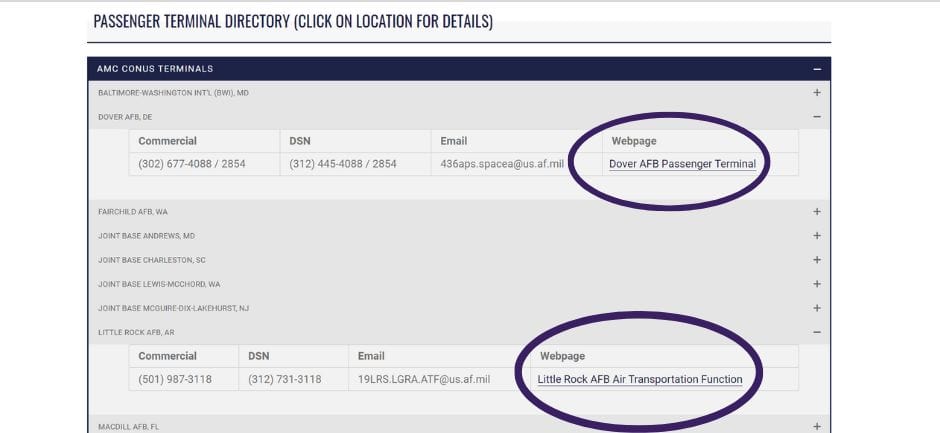
Now that you know where the military passenger terminals are located, here are a few ways to figure out where to start your journey.
Patriot Express Missions: Fixed Routes and Schedules
The only military missions that have fixed routes and schedules are Patriot Express (PE) missions. Also known as “the rotator,” the PE is a commercial charter flight used primarily to transport space-required passengers to and from duty stations outside the contiguous United States (OCONUS).
PE missions have set routes that are generally consistent over the course of the year. For example, the Seattle Tacoma International AMC terminal only has missions to and from Guam, Korea, and Japan. Periodically, adjustments are made to the order and frequency of stops, but the terminal does not have missions to or from any other locations.
The CONUS locations that have PE missions and the destinations they serve are as follows:
- Seattle-Tacoma International AMC terminal (Guam, Japan, and Korea)
- Baltimore-Washington International AMC terminal (Germany, Turkey*, Kuwait*, Qatar*, and Greenland*)
- Naval Station Norfolk (Spain*, Italy, Greece, Cuba*, Bahrain*, Diego Garcia*, and Djibouti*)
- Travis Air Force Base (Hawaii)
- Naval Air Station Jacksonville (Cuba*)
PE schedules, which show destinations and departure dates (but not times), are published for one calendar month at a time. The schedules are usually available a few days before the end of the month for the following month.
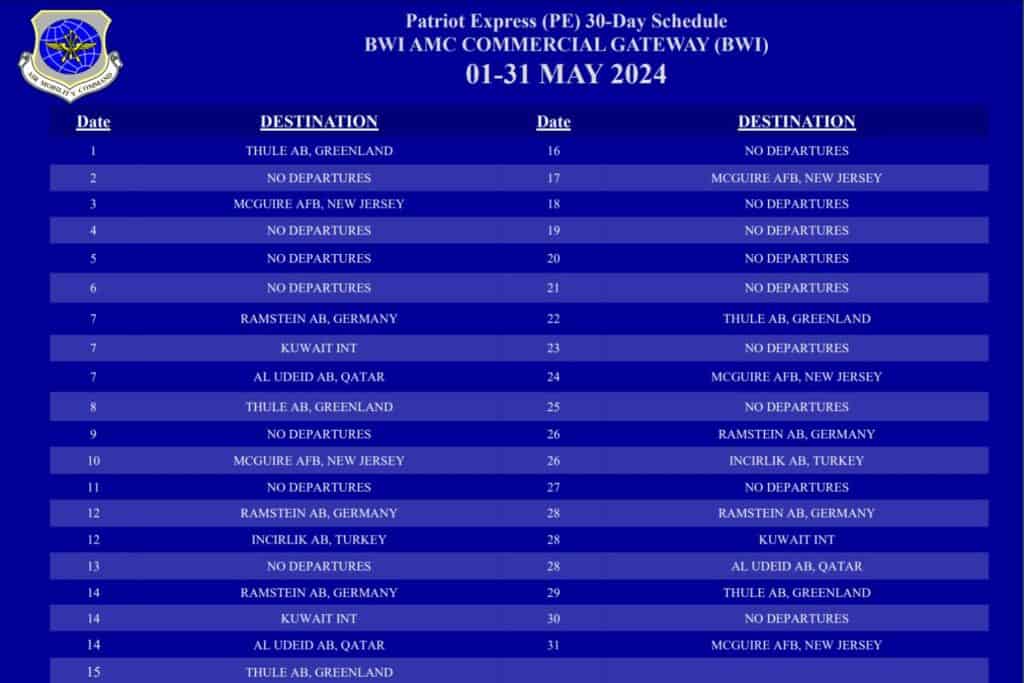
For more information about flying Space-A on the Patriot Express, including a list of all PE routes, read this article.
*Locations with an asterisk are not accessible to all Space-A passengers. See the article about flying Space-A on the Patriot Express for more details.
Poppin’ Smoke’s Space-A Location Guides
Poppin’ Smoke has detailed guides to the most active military passenger terminals for Space-A opportunities around the world. The guides list the locations with the most frequent missions to and from those terminals.
As noted above, a base could have a flight to any destination, as dictated by mission needs, but the guides give you an idea of where you should start if you’re hoping to travel to a particular destination.
Here are a few examples of the type of information about a location’s missions you can glean from the guides:
- Travis AFB is the best place in CONUS to start if you want to fly Space-A to Hawaii.
- Naval Station Norfolk is the starting point for two Patriot Express routes to bases in Europe but also has missions on cargo aircraft.
- If you want to fly Space-A to Japan from CONUS, make your way to Travis AFB or the Seattle AMC terminal.
Note that the Space-A Location Guides include a wealth of other important information about each terminal, including lodging, parking, and ground transportation options, plus details about what to expect at the terminal and, for overseas bases, immigration procedures.
Military Passenger Terminal Flight Schedules
Understanding PE routes and using Poppin’ Smoke’s Space-A Location Guides will give you a solid overview of the most active terminals in the Space-A program and where they fly most often. But if you want to learn about other passenger terminals or follow the bases closest to you to learn exactly where they’ve had missions, you will need to monitor flight schedules.
This is the most “manual” way to figure out where bases fly most often, but it’s important to do it regularly until you start to see patterns in where particular bases have regular missions.
There are two main ways to monitor military flight schedules:
- Calling the passenger terminal and listening to their automated flight recording.
- Viewing the passenger terminal’s schedules online, if applicable, as discussed below.
You can find each terminal’s phone number and website in the AMC Travel Site’s passenger terminal directory referenced above.
Except for the PE, most military flight schedules are published 72 hours in advance, and you cannot access old schedules. For example, on a Monday you can view (or listen to) departures for Monday, Tuesday, and Wednesday. But on Tuesday, you can no longer see/hear the Monday flight schedule.
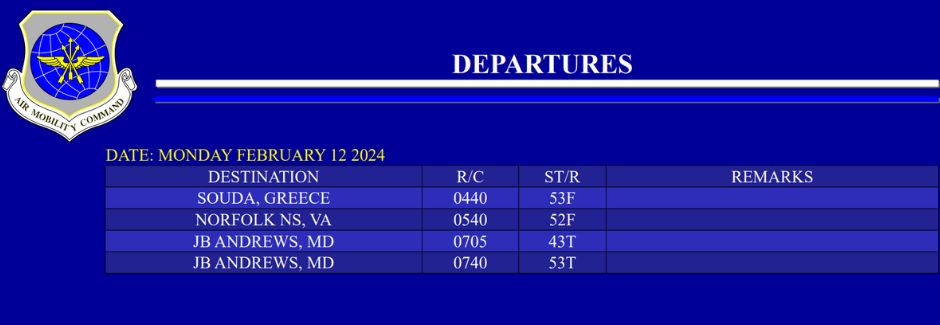
A small number of military passenger terminals also list arriving flights on their 72 hour schedules, which gives you some extra data points.
In addition to the 72-hour schedules, most AMC passenger terminals publish Roll Call reports, which show data on recently departed flights. The reports vary in terms of how many days of historical data they show. Some terminals list only flights within the past 24 hours, while others display up to a week of data. Roll Call reports are not available by phone.
Most non-AMC terminals do not post schedules online, so your only option is to call them for information.
*** All of this means that you must view or listen to flight schedules at least every few days if you want a full picture of the missions from a particular terminal ***.
This article has step-by-step instructions for finding military flight schedules online and provides a detailed explanation of the information included in the reports.
Putting It All Together: Where to Start Your Space-A Adventure
If you’re ready to try Space-A, the first thing to do is to figure out which bases near you have flights that could get you to your destination.
In some cases, there are many possible paths you could take. For example, if you are on the East Coast and want to travel to Germany, you could fly from one of several bases that have regular missions into Ramstein Air Base. (Hint: check out our Ramstein Space-A Location Guide to find out what those bases are).
If you’re coming from another part of the U.S., you could also take multiple “hops” (e.g. JB Lewis-McChord to JB Andrews and JB Andrews to Ramstein).
Keep in mind that you may need to combine Space-A travel with other transportation. If you don’t live near a base with regular Space-A opportunities, you will need to find other means of transportation to one of the active Space-A hubs. Similarly, you might fly Space-A to a base overseas, and then take a train or civilian flight to your final destination.
Knowing where you could start your Space-A journey is just one piece of the puzzle, and it’s very important to understand the full picture before attempting your first hop.
- Read our Quickstart Guide to Military Space-A Flights carefully and follow any links that relate to your situation.
- Once you understand how the Space-A flying process works, check out the strategies we use for a successful Space-A adventure to inform your decision-making when planning your trip.
- Finally, review our Space-A packing list to make sure you have the clothing, gear, and documents you need to fly Space-A!
Whew! I know it’s a lot to digest. But maximizing your chances of getting to your destination when flying Space-A requires you to understand the entire process and how the rules and regulations work. You will learn more each time you fly, but you can set yourself up for success by doing your homework before you begin your journey!
The appearance of U.S. Department of Defense (DoD) visual information does not imply or constitute DoD endorsement.

This is a wonderful guide to SpaceA! Thank you for all you do.
Thank you, Judy!